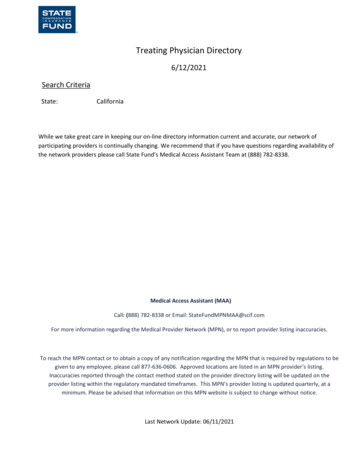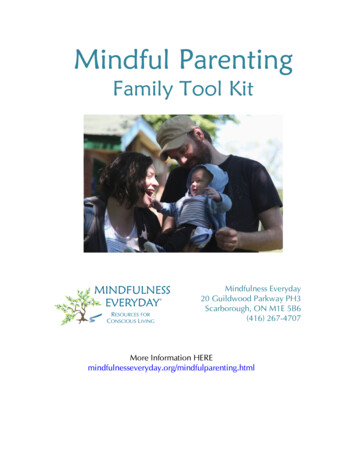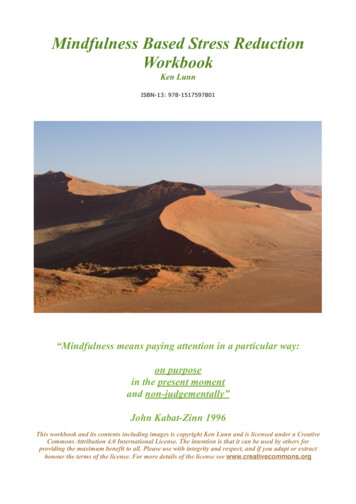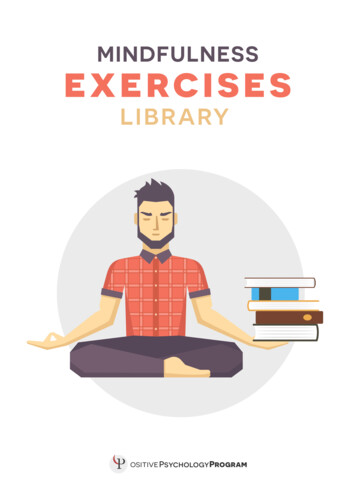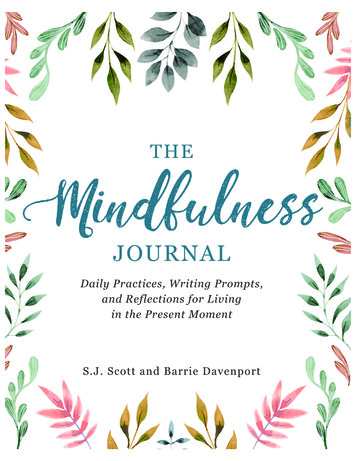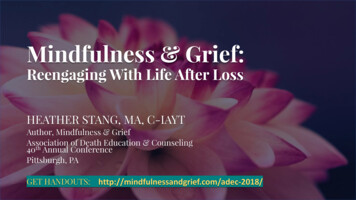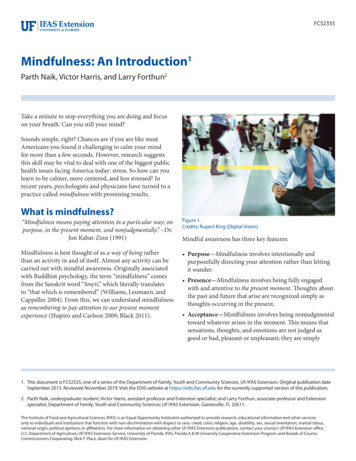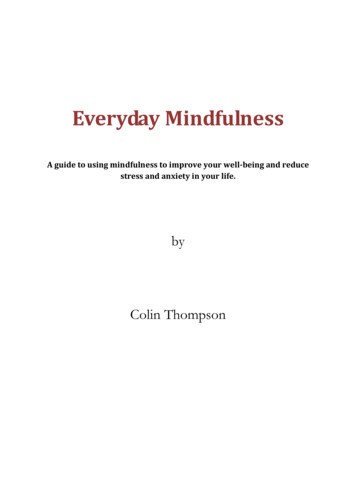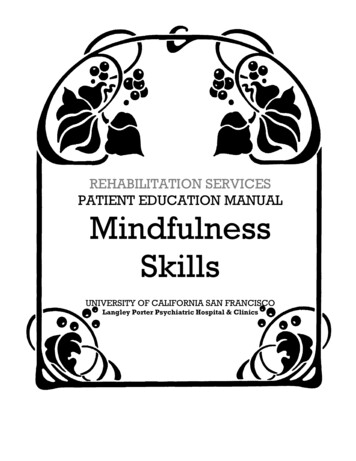
Transcription
TEDUCATIONMANUALPATIENT EDUCATION ERSITY OF CALIFORNIA SAN FRANCISCOLangley Porter Psychiatric Hospital & ClinicsUNIVERSITY OF CALIFORNIA SAN FRANCISCOlhiii lCli i
MINDFULNESS SKILLSMindfulness Skills help you to balance youremotions, thoughts and behaviors. The focus ofthese skills is to learn to be in control of your ownmind instead of having your mind control you. Inmany of our verbal group therapies and expressivearts therapies, we introduce and practicemindfulness skills, because that is what this takes,lots of practice KEY STRATEGIES INCLUDE1.2.3.Learning to focus your attentionLearning to concentrate on a taskLearning how to stop negative thoughts
REASONABLE MINDYour Reasonable Mind is the part of you that plans andevaluates things logically and intellectually. You can think of itas your “cool” part (if you remember “SPOCK” from the StarTrek TV series, he’s kind of like that). Without ReasonableMind, people could not build homes, roads or cities. Theycould not run meetings, balance checkbooks or followinstructions. When we’re feeling unwell or distressed, it’sharder for our Reasonable Mind to function.How do you experience your Reasonable Mind? What are youdoing when you’re in that state of mind? Draw or writesomething in the circle below that expresses your experienceof Reasonable Mind.
EMOTIONAL MINDYou are in your Emotional Mind whenyour emotions are in control, when theydrive your thinking and your behavior.Don’t think of your Emotional Mind as a bad thing. Intense love often motivates us;strong desires can keep us focused on a hard task. People high in Emotional Mindare often passionate about people, causes and beliefs.Emotional Mind is your “hot” part. When you’re in your Emotional Mind, it’s veryhard to think logically. Facts get distorted by whatever intense emotion you’refeeling. It’s as though you see everything through emotion-colored shades.How do you experience your Emotional Mind? In the circle below draw or writesomething that expresses your experience of Emotional Mind.
WISE MINDWise Mind is a balancing or blending of yourReasonable Mind and your Emotional Mind.You can’t overcome your Emotional Mind withyour Reasonable Mind. Nor can you createemotions with reasonableness or logic. Youmust go within and integrate the two.Wisdom or Wise Mind depend on ways of knowing something; knowing byobserving or by analyzing logically, knowing by recognizing your bodyexperiences or emotions, knowing by what you do and by your intuition.Everyone has a Wise Mind, but some people have not experienced it. Wise Mind islike having a heart. Everyone has a heart, whether they experience it or not. Hereare some ways people experience Wise Mind:It feelsquiet andpeacefulI’m in Wise Mindwhen I listen to myinner voiceIt’s thecalm that follows thestorm after the chaos It’s seeing and knowingsomething clearlyIt’s thatplace in mewhere I knowwhat I knowis trueWhenI’minnatureI’m inWise Mindwhen I trustmyintuitionI feelit when Ifollow mybreath inand outI feelWise Mindbetween myeyesIexperienceit in thecenterof my body*In mybelly
HOW DO YOU EXPERIENCE YOURWISE MIND?Draw or write something in the circle below thatexpresses your experience of Wise Mind.
FINDING WISE MINDFinding Wise Mind is like riding a bike, rollerblading orswimming. You can only learn it by experience and practice.Finding Wise Mind in Two Steps1. Follow your breath in and out as you breathenaturally and deeply.2. After some time, try to let your attention settle to thecenter at the bottom of the breath, between theexhalation and the inhalation. That centered point isthe Wise Mind.What happened for you? What did you notice?No one is in Wise Mind all the time. Like a garden, the Wise Mind needs to becultivated. The more you practice, the easier it is to find that wise place in yourself,and the longer you will be able to hold it.As you go through your day today, give yourself“Wise-Mind-Breaks” and notice what happens.
MINDFULNESS SKILLSMindfulness Skills are the first to be taught and are the core ofall the DBT (Dialectical Behavioral Therapy) Skills taught inmany of our verbal and expressive arts therapy programs.These skills are drawn from both Western and Easternmeditation practices. Mindfulness Skills are the vehicle forbalancing “Emotional Mind” and “Reasonable Mind” toachieve “Wise Mind”. Mindfulness means learning to takecontrol of your mind instead of your mind controlling you.TAKING HOLD OF YOUR MIND(“WHAT” DO YOU DO)1. OBSERVING: Notice events, emotions and behaviors without trying tostop them when they’re painful, and without trying to keep them goingwhen they’re pleasant. Learning to observe is learning to detach or stepback from an event or emotion. Observing is like sensing, there are nowords. It’s like seeing things the way a camera would see, withoutjudgment just what is.2. DESCRIBING: Use words or thoughts to identify or label a feeling orexperience. Describing is using words to identify what the “camera saw”,without judgment just the facts.3. PARTICIPATING: Involve yourself completely and totally in the oneactivity you are doing at the time.Which of these “WHAT” skills is your strength? Which is your weakness?The most difficult one is the one to practice most.Turn to the next page for theTAKING HOLD OF YOUR MIND - “HOW”-SKILLSTAKING HOLD OF YOUR MIND(“HOW” DO YOU DO IT)
1. NON-JUDGMENTALLY: Learn not to judge. Thismeans seeing but not evaluating. Focus on the “what”,not the “good” or “bad”, the “terrible” or “wonderful”,the “should” or “should not”.2. ONE-MINDFULLY: Do one thing at a time. If thoughtsor strong feelings distract you, let go of the thoughts, letgo of the feelings go back to what you were doing –again and again and again. Concentrate your mind. Ifyou find yourself doing two things at once, stop and goback to doing one thing at a time.3. EFFECTIVELY: Focus on what works. Do what needs tobe done in each situation. Play by the rules – don’t “cutoff your nose to spite your face”. Act as skillfully as youcan in the situation you’re in. Let go of vengeance,useless anger and righteousness that hurts you anddoesn’t work.REMEMBERMindfulness Skills take time and can only be mastered with practice, practice, practice.Be patient with yourself. Do your best. But know that your best when you’re feelinggreat is different than your best when you are depressed. Do your best today.
PRACTICING:OBSERVE, DESCRIBE, PARTICIPATETry some of the following exercises and then writedown a few words to describe your experience.Attend to and try to sense your feet, yourstomach and your shoulders. What do you notice?Stroke your finger just above your lip, then stop stroking and noticehow long it takes before you can’t sense your upper lipany longer. What did you notice?Listen to the sounds in the room. What did you notice?Imagine your mind is the sky andthoughts, sensations and/or feelingsare clouds. Gently notice each cloudas it drifts by (or scurries by). Whathappened in your mind?WALKING
MEDITATIONMost people cover miles in the course of their daily routine.This makes walking a great opportunity to practicemindfulness. You can focus on the act of walking in the sameway you would focus on your breath in a sitting meditation.One way of practicing walking meditation is to count your stepsin time with your breathing. For instance, if you take threesteps during each inhalation and exhalation, mentally say toyourself:“In two three - Out two threeIn two threeOut two three” and so on.Your “IN” breaths may be longer or shorter than your “OUT”breaths. Or your step count may change from breath to breath.That’s OK. Just pay attention and re-adjust your walking to theins and outs of your breathing as needed.When thoughts or images interrupt your focus, which is naturaland inevitable, simply take note of this and return to yourwalking and breathing.Walk around countingyour steps.What did you observe?Did anything change in you?“If you’re going through hell, keep going” --- Winston Churchill
SEEING MEDITATIONFind an object within your line of vision that you might want to fix your eyes on apainting, a wall or a plant. Take several belly breaths and glue your eyes to theobject. Let it capture your interest, as though it were the only object around you. Trynot to judge what you are seeing. Look at it as an artist might: lines shapes colors.See if you can have the experience of “just seeing”. When thoughts arise, noticethem and return your focus to the object.What did you notice?Try to describe the object in words or draw a picture of it in the space below.SIMPLE MEDITATIONAny simple activity can become a meditation when you try to continuously focusyour attention on it. A good mindfulness exercise to do is to choose an activity youdo every day, preferably a short one like brushing your teeth, washing your faceor drinking a glass of water. Practice concentrating on every action and everysensation involved in the activity. As thoughts occur, notice them and then go backto the task with renewed concentration. Sometimes it helps if you switch to your nondominant hand when you do the activity. The awkwardness is a reminder that youwant to concentrate on what you’re doing.
LOVING KINDNESS MEDITATIONMay I be safe, happy,and free from suffering.may I be at peace.May my loved ones andfriends be safe,happy, and free fromsuffering.May my friends and lovedones be at peace.May all beings be safe,happy and free fromsuffering.May all beings be atpeace.
Another way to think of MindfulnessMindfulness is like holding aflashlight in a darkened room andshining it where you choose.Mindfulness is the learned ability tofocus the mind and your immediateawareness on what you decide ishelpful in the moment. Mindfulnessit the ability to “control theflashlight” Mindfulness of body sensationsMindfulness of thoughtsMindfulness of emotions
RESOURCE LIST FOR ADDITIONAL READINGSThis manual is part of a four manual series discussing Mindfulness Skills, DistressTolerance Skills, Emotion Regulation Skills and Interpersonal Effectiveness Skills. Ifyou would like additional reading materials or resources related to the skillsdiscussed in these manuals, we would like to direct you to the following:Don't Let Your Emotions Run Your Life: How Dialectical Behavior Therapy Can PutYou in Control by Scott E. Spradlin, MA, New Harbinger Publications, 2003.The Feeling Good Handbook by David D. Burns, M.D., Penguin Books, 1999.Full Catastrophe Living: Using the Wisdom of Your Body and Mind to Face Stress,Pain, and Illness by Jon Kabat-Zinn, Ph.D., Dell Publishing, 1990.Guided Meditations, Explorations and Healings by Stephen Levine, Doubleday, 1991.The Language of Letting Go by Melody Beattie, Hazeldon Foundation Meditation Series,1990.Practicing the Power of Now by Eckhart Tolle, publisher New World Library,(www.newworldlibrary.com), 1999.The Relaxation & Stress Reduction Workbook by Martha Davis, Ph.D., New HarbingerPublications, 2000.The Spirituality of Imperfection by Ernest Kurtz, Ph.D., Bantam Books, 1994.Turning Suffering Inside Out:A Zen Approach to Living with Physical and EmotionalPain by Darlene Cohen, Shambhala Publications, 2000.Women, Anger & Depression: Strategies for Self Empowerment by Lois P. Frankel,Ph.D., Health Communications, Inc., 1992.TAPES AND CDsGuided Mindfulness Meditation by Jon Kabat-Zinn, Stress Reduction CDs and Tapes, P.O.Box 547, Lexington, MA 02420 or www.mindfulnesstapes.comACKNOWLEDGEMENTMany of the materials discussed in these manuals are based on the works of Marsha M.Linehan, Ph. D. as presented in her books Cognitive-Behavioral Treatment of BorderlinePersonality Disorder and Skills Training Manual for Treating Borderline PersonalityDisorder. Both are available through the Guilford Press, 1993.
Mindfulness Skills are the to be taught and are the core of first all the DBT (Dialectical Behavioral Therapy) Skills taught in . Pain, and Illne ss by Jon Kabat -Zinn, Ph.D., Dell Publishing, 1990. Guided Meditations, Explo
